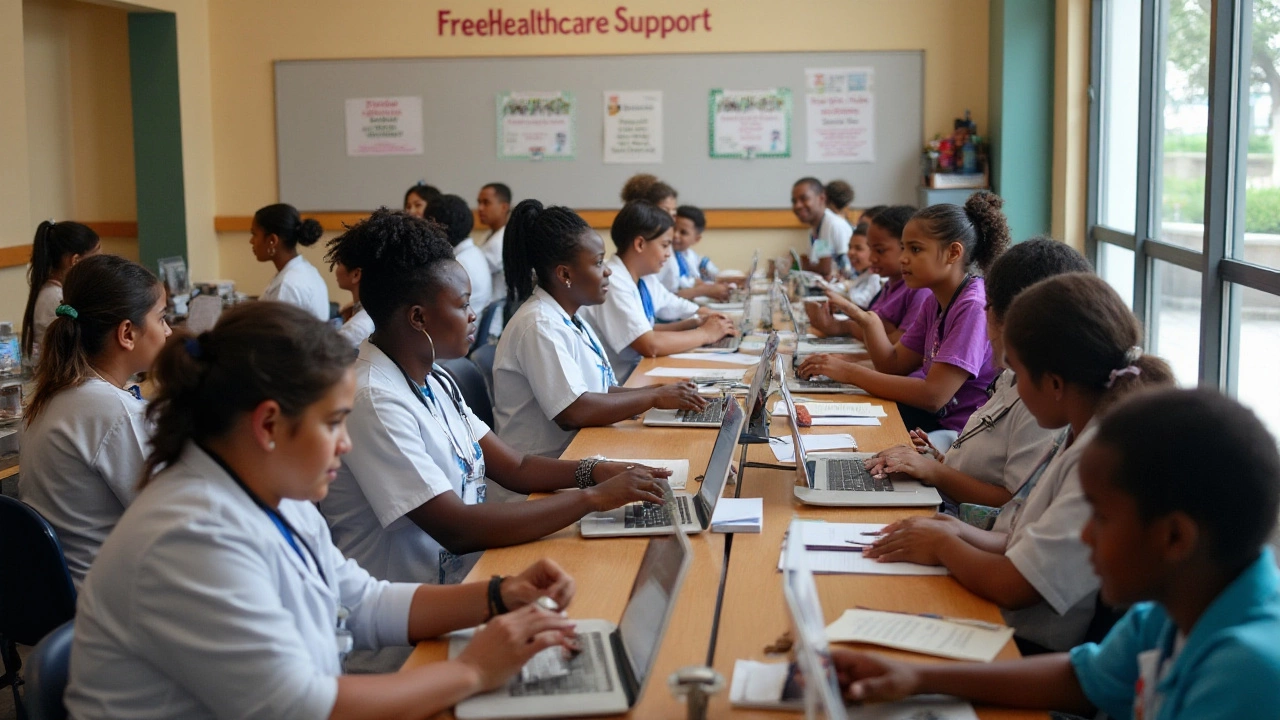Understanding Benefits for Low-Income Families in Texas: A Guide to Support Resources
 Jan, 13 2025
Jan, 13 2025
In a state as large and diverse as Texas, understanding the resources available for low-income families can make a significant difference in navigating life's challenges. With many residents grappling with financial difficulties, knowing where to turn for support can offer crucial relief. From housing subsidies to food programs, Texas offers a variety of benefits to support those in need, including options for the homeless.
This article seeks to illuminate these valuable resources. By examining the range of assistance available, we'll explore how those facing economic hardships can access essential services. Whether it's through health care options, educational support, or employment opportunities, these programs aim to provide a pathway toward stability and self-sufficiency. Join us as we uncover the strategies and stories that can make a positive impact.
- Housing and Shelter Programs
- Nutritional and Food Assistance
- Healthcare Services
- Education and Employment Opportunities
- Application Process and Tips
Housing and Shelter Programs
For families and individuals grappling with homelessness or housing insecurity, finding stable shelter is often the first step towards regaining confidence and rebuilding their lives. In Texas, a range of programs cater specifically to low-income residents looking for housing solutions. Homeless shelters across the state provide not just a bed for the night, but also the necessary support to find more permanent housing options. These programs aim to lift individuals out of temporary hardship and towards sustainable living conditions.
A mainstay among Texas's housing initiatives is the Section 8 Housing Choice Voucher Program, which enables participants to secure affordable housing in the private market. The program funds a portion of rent directly to landlords, easing financial burdens on low-income families. For those needing a more immediate solution, emergency shelters are scattered across the state, supplying critical short-term relief. These shelters often collaborate with local agencies to offer services like job placement, counseling, and educational support.
Community-driven initiatives also play a vital role in combating homelessness. Non-profit organizations and government alliances often develop supportive housing projects that address the comprehensive needs of their tenants beyond just shelter. This wrap-around approach fosters stability by connecting tenants with healthcare, employment training, and educational resources.
"Securing a safe place for these families is not just about giving them shelter. It's about providing them with dignity and hope for a better tomorrow," says a spokesperson from Texas Homeless Network.
Housing affordability is another pressing challenge, and Texas tackles this with various state-funded programs. The Texas Department of Housing and Community Affairs extends grants and loans to low-income households looking to secure mortgages. Additionally, public housing authorities maintain lists of affordable accommodations tailored to meet community demand, creating a reliable nexus of information for potential applicants. To get the most out of these resources, knowing how to navigate the application process is key.
The process for applying to these programs involves several steps. Prospective participants usually need to provide proof of income, family size, and housing status. For some programs, joining a waitlist is necessary due to high demand, but persistence pays off. It's helpful to connect with local housing authorities who can offer guidance and advocacy throughout the application process. Many also provide workshops to aid applicants in successfully securing housing benefits.
Despite the challenges, these initiatives reflect a hopeful landscape for those struggling with poverty in Texas. By combining governmental support, community activism, and personal perseverance, homeless shelters and housing programs work in tandem to create real change in the lives of those they serve. As the state strives for innovation in addressing housing needs, Texans continue finding ways to transform temporary arrangements into lasting stability. This concerted effort holds promise for brighter futures and more secure living for countless families.
Nutritional and Food Assistance
Ensuring access to adequate nutrition is a cornerstone of well-being, and Texas recognizes the importance of providing nutritional support to its residents facing financial hardships. The state offers a plethora of programs designed to help low-income families access essential food resources. Among these, the Supplemental Nutrition Assistance Program (SNAP) stands out as a crucial lifeline. Formerly known as food stamps, SNAP offers monthly benefits that recipients can use to purchase food at authorized retailers. The eligibility for SNAP is typically based on factors like income, household size, and expenses, making this program accessible to many struggling families in Texas.
Besides SNAP, Texas also administers the Women, Infants, and Children (WIC) program, which targets the nutritional needs of pregnant women, new mothers, and young children. WIC provides nutrient-rich foods, nutrition education, and even breastfeeding support. Families participating in WIC can access a combination of healthy foods and resources that are pivotal for growth and development during early childhood. Furthermore, the program often partners with local communities to offer free health screenings and referrals for medical care, ensuring holistic support.
One of the unique aspects of the nutritional support landscape in Texas is the involvement of numerous non-profit organizations and local food banks. For example, the Central Texas Food Bank is pivotal in supplementing government efforts by distributing meals to those in need through a network of partner agencies. Their Mobile Food Pantry extends its reach to rural and urban areas alike, ensuring that access to food is not hampered by location. This community collaboration means that no matter where individuals live in Texas, they are likely to find a food pantry or community kitchen willing to lend a hand.
According to Feeding Texas, "One in seven Texans experiences food insecurity, which means many families are often choosing between food and other essentials." This stark reality underscores the significance of programs and organizations focused on nutritional support.
For children, the School Breakfast and National School Lunch Programs provide vital meals during the academic year. During the summer, when school is out of session, the Summer Food Service Program steps in to fill the gap, offering free meals and snacks to children in low-income communities. These programs are crucial in alleviating hunger among children and ensuring they have the fuel needed to succeed in school and life. Studies have demonstrated their effectiveness in improving nutritional intake, supporting cognitive development, and even enhancing academic performance.
The process of applying for these food assistance benefits can vary, but information is readily available through Texas Health and Human Services. Applicants often need to provide proof of residency, income, and identification. It's important to note that assistance isn't limited to U.S. citizens; legal immigrants and certain categories of other immigrants can also access these benefits. By understanding their eligibility and available resources, families can mitigate the stress of food insecurity and focus on building a brighter future. This approach to holistic nutritional care in Texas provides a model that integrates governmental programs with local supportive networks.

Healthcare Services
Access to adequate healthcare services is a fundamental necessity for everyone, yet it remains a significant challenge for many low-income individuals in Texas. Fortunately, various programs and initiatives aim to bridge the gap, ensuring that financial difficulties do not become a barrier to receiving essential medical attention. The Texas Medicaid program is a cornerstone of this support network, offering comprehensive coverage to eligible residents. It provides everything from hospital and physician services to prescriptions, dental care for children, and preventive services. Those enrolled can expect to have access to a wide range of healthcare providers across the state, making it easier to find the specialized care they may need.
Another critical program is the Children's Health Insurance Program (CHIP), which extends medical assistance to children in families who earn too much to qualify for Medicaid but still cannot afford private insurance. CHIP coverage includes check-ups, immunizations, hospital care, and even emergency services. Families are encouraged to apply, as it allows children to receive the necessary care during critical developmental years. These programs seek not only to address immediate health concerns but also to promote long-term well-being through continuous care.
The spotlight on mental health services is also increasing, and Texas is stepping up efforts in this domain. Mental health programs, often underfunded, are crucial for supporting individuals dealing with stressors related to homelessness or financial instability. Local agencies often collaborate with governmental bodies to provide therapy, counseling, and psychiatric support within accessible community health centers. These centers work hard to foster environments of hope and healing, recognizing how mental health is inseparable from physical health. By prioritizing this sphere, Texas aims to create integrated networks of care that emphasize comprehensive wellness.
"Ensuring access to healthcare for all Texans, regardless of income, is not just a policy goal but a moral imperative," said a representative from the Texas Health and Human Services Commission.
Community Clinics and Preventive Care
Community clinics represent another lifeline, focusing on preventive care that can prevent minor issues from becoming major health crises. Accessible throughout Texas, these clinics offer sliding fee scales based on income, ensuring that charges remain affordable. Services typically include check-ups, immunizations, chronic disease management, and more. They often partner with local organizations to provide education on important health topics like nutrition and exercise, fostering a proactive approach to personal health management. Such services are critical in managing healthcare costs over the long term by reducing the need for expensive emergency room visits.
For the uninsured or underinsured, Texas promotes several initiatives designed to improve healthcare access. The Health Insurance Marketplace remains a viable option during open enrollment periods, offering plans that consider financial constraints. Subsidies can often lower premiums, making comprehensive healthcare more attainable. Additionally, county indigent health care programs are available to assist those without other means to pay for care, thus ensuring even the most vulnerable citizens can receive necessary services.
Education and Employment Opportunities
For low-income families in Texas, gaining access to education and employment resources can play a pivotal role in achieving long-term economic stability. The state is home to numerous programs specifically designed to support both students and job seekers from disadvantaged backgrounds. This section aims to explore the variety of initiatives available, focusing on how they bridge the gap between hardship and opportunity.
Texas's commitment to education is reflected in several programs that offer financial aid and support services to students from low-income families. The Texas Education Agency provides various scholarships and grants to ensure that economic constraints don't hinder academic aspirations. One noteworthy initiative is the Texas Grant Program, which provides funding to help eligible students cover tuition and fees at public universities. Additionally, the Texas Workforce Commission offers Adult Education and Literacy programs aimed at improving basic skills, which are often prerequisites for both higher education and employment.
On the employment front, the state offers an array of workforce development programs tailored to meet the needs of low-income individuals. The Texas Workforce Solutions partners with local businesses and educational institutions to provide job training opportunities, internships, and apprenticeships. These programs focus on equipping participants with relevant skills that increase their employability in Texas's diverse job market. According to a report by the Texas Workforce Commission, the state's job training initiatives have helped reduce unemployment rates among participating low-income families by a notable margin.
"Investing in workforce education is crucial for communities, as it creates pathways out of poverty and reduces reliance on public assistance," says Maria Garcia, a policy analyst with the Texas Workforce Commission.
Moreover, the state's network of community colleges offers expansive workforce education programs designed to align with key industries such as healthcare, technology, and energy – sectors with high demand for skilled workers. Texas residents can access these vocational training programs with reduced or even waived tuition, depending on their eligibility. Recent data illustrates that individuals who complete such vocational programs experience higher employment rates and earning potential compared to their counterparts without formal training.
For those seeking self-sufficiency through entrepreneurship, Texas also provides resources to help start and grow businesses. The Texas Economic Development website features programs like the Governor's Small Business Resource Portal, which provides information on business planning, funding sources, and mentoring opportunities. These platforms collectively foster an environment where aspiring entrepreneurs from low-income backgrounds can thrive.
To navigate these opportunities, it's crucial for individuals and families to be aware of the application processes and eligibility criteria for these programs. Many resources require proof of income, residency, and other documentation that applicants must prepare in advance. Consulting with local educational institutions and workforce centers can also offer guidance and support, ensuring that those in need can effectively access and utilize these life-changing opportunities.

Application Process and Tips
When starting the journey to access benefits in Texas, it's crucial to understand the application process clearly. The first step often involves determining eligibility based on income, family size, and specific needs. This can vary significantly, with many programs catering to distinct groups such as families, veterans, or the elderly. Navigating these requirements might feel daunting, but Texas offers numerous resources to assist applicants in making informed decisions. From online portals to community centers, help is never too far away.
Applying for benefits such as housing or food assistance usually entails gathering essential documents such as identification, proof of residency, and income statements. Once these are in hand, applicants can proceed via online applications, mail, or in-person visits. For those seeking assistance with homeless shelters and housing, the Texas Department of Housing and Community Affairs provides a centralized platform where individuals can find information and apply for aid. Patience is key, as processing times may vary depending on demand and specific program requirements.
Tips for Successful Applications
For many low-income families or individuals teetering on the edge of homelessness, navigating aid programs can be overwhelming. But there are strategies to smoothen this process. Staying organized by keeping all documentation neatly filed is a simple yet effective approach. Ensuring that all required fields are accurately filled out prevents common delays. Should uncertainties arise, it's beneficial to utilize helplines or consult with local advocacy groups well-versed in assistance programs. As an insightful piece from the Austin American-Statesman noted, "Local shelters and food banks not only provide immediate aid but also serve as gateways to larger networks of support."
"Individuals making the leap from uncertainty to security walk paths carved by those who dared to navigate the maze of bureaucracy before them with curiosity, courage, and a sense of possibility." — Mary Clark, Social Work Expert
Texas has seen increasing demand for benefits, prompting the state to enhance its service delivery. Nevertheless, it's crucial for applicants to remain proactive during the waiting period. Regularly checking the status of applications can pre-empt any unforeseen issues, ensuring timely intervention if necessary. Attending informational workshops hosted by community groups offers a dual benefit of learning and networking with others in similar situations. Adding a personal touch by writing an accompanying letter—when applicable—might engage reviewers more personally, highlighting the urgency or specificity of individual needs.
Ultimately, while embarking on this process might feel isolating, applicants should remember they're not alone. With over 4 million Texans relying on some form of assistance, myriad others have walked this very pathway. From leveraging online resources to engaging with local initiatives, support is always at hand, making the journey toward securing necessary benefits in Texas not just possible but within reach for all.
